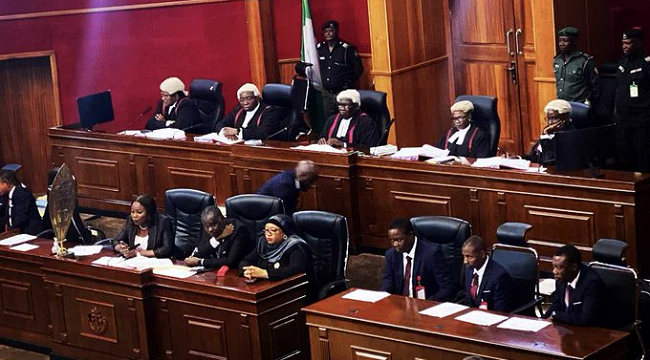SUPREME COURT JUDGEMENTS 17/01/2023
Crucial Nature Of Identification Of Suspect In Securing Conviction

In the Supreme Court of Nigeria
Holden at Abuja
On Friday, the 2nd day of December, 2022
Before Their Lordships
Kudirat Motonmori Olatokunbo Kekere-Ekun
Uwani Musa Abba Aji
Adamu Jauro
Tijjani Abubakar
Emmanuel Akomaye Agim
Justices, Supreme Court
SC.526/2017
Between
Fagbile Ebenezer … … … Appellant And
The State … … … … … Respondent
(Lead Judgement delivered by Honourable Kudirat Motonmori Olatokunbo Kekere-Ekun, JSC)
Facts
The Appellant and three others were charged before the High Court of Ekiti State, Ado-Ekiti Division, on a two-count charge of armed robbery contrary to Section 1(2)(a) of the Robbery and Firearms (Special Provisions) Act Cap. R.11, Laws of the Federation of Nigeria, 2004. All accused persons pleaded not guilty, to the counts.
The case of the Respondent, as chiefly narrated by the victim, Honourable Justice Ayewole Agbelusi, a Judge of the High Court sitting at Ijero-Ekiti (PW1), was that on 15th September 2012, on or about 3am, the 1st accused person woke him from his sleep with a gun to his ear. According to PW1, he was able to see the 1st and 2nd accused persons, when the 1st accused person switched on his reading light. PW1 remarked that both the 1st and 2nd accused persons were in his room, and unmasked. Further, that while still at gun point, the 1st accused person demanded for his valuables. PW1, therefore, led the 1st accused person to where he kept N35,000.00, his handsets and other items. It was his evidence that while he was led out of the room by the 1st and 2nd accused persons, he met the Appellant, who was armed with a gun.
PW1 testified that he and his household were locked up in a toilet, though his daughters were taken elsewhere. He mentioned that about forty-five minutes later, one of his children jumped out through the toilet window and freed his household, realising that the armed robbers had left PW1’s home on motorcycles. Subsequently, he immediately lodged a complaint at New Iyin Police Station, Ekiti State, after which he and his household went to the hospital for treatment. PW1 later returned to the Police Station, upon information that some suspects had been arrested. He testified that at the station, many suspects were lined up and he was able to identify the accused persons as the armed robbers because they were wearing the same clothes they wore during the robbery. There was no evidence that PW1 gave the Policemen a description of the alleged armed robbers, prior to the identification parade. PW1 added that another Identification Parade was carried out at the Police Headquarters sometime on 19th September, 2022. During the exercise, PW1 and his daughter were able to identify the accused persons as the armed robbers.
Upon their arraignment, the accused persons set up a defence of alibi, where they claimed that they were all working on a building site close to where the robbery took place, at the point of their apprehension. They denied knowing the 4th accused person who happened to be PW1’s driver. One Tunde Onikoyi (DW5) who testified in favour of the accused persons, also claimed not to know the 4th accused.
At the close of trial and adoption of written addresses, the trial court acquitted the 4th accused person. However, the other three accused persons were found guilty of armed robbery, but acquitted and discharged on count two. Thus, the accused persons were each convicted and sentenced to death by hanging. The Appellant, thus, appealed against the decision.
At the Court of Appeal, the conviction and sentence of the Appellant was affirmed. Further, the Appellant lodged the instant appeal at the Supreme Court.
Issues for Determination
The Supreme Court adopted the issues formulated by the Appellant (which were similar to those posed by the Respondent) in its determination of the appeal, thus:
1. Whether the lower court was right in affirming the decision of the learned trial Judge that the prosecution led credible evidence of identification of the Appellant as one of the robbers that attacked PW1, and whether the defence of alibi avails the Appellant? (Grounds 2, 3 and 4)
2. Whether having regard to the circumstances and from the totality of the evidence on record, the lower court was right in upholding the decision of the trial court that (the) prosecution proved the offence of armed robbery against the Appellant beyond reasonable doubt? (Grounds 1, 5, 6, 7 and 8).
Arguments
Arguing the appeal, counsel for the Appellant contended that in establishing ingredients for proof of armed robbery, the court is enjoined to consider (a) the circumstances in which the eye witness saw the suspect; (b) the length of time during which the eye witness saw the suspect; (c) the opportunity of close observation; (d) previous contact between the witness and the suspect; and (e) the lighting conditions at the time of the robbery – OCHIBA v THE STATE (2012) All FWLR (Pt. 608) 849 at 871. Counsel submitted that the above burden was not discharged by the Respondent. He argued that the Respondent’s evidence shows that the 1st and 2nd accused persons were the ones in the room with the Appellant, and given the alleged trauma experienced by PW1 in the hands of the 1st and 2nd accused persons, he could not have been in the right frame of mind to recognise or identify the Appellant, as one of the armed robbers who attacked him.
It was also the submission of counsel on behalf of the Appellant that the first identification parade was weak and unreliable, in light of the fact that PW1 could only claim to identify the Appellant after spending time at the office of the Police officers. He argued further that the Identification Parade was superfluous, as PW1 held himself out as being able to properly identify the accused persons having seen them before at New Iyin Police Station before identifying them at the Police Headquarters. Also, the Appellant, who testified as DW3, stated that PW1 did not identify him during the Identification Parade.
Regarding the defence of alibi, counsel submitted that this was raised at the earliest opportunity in the Appellant’s extra-judicial statement, yet the Respondent’s PW3 and PW4 who obtained the extra-judicial statements of the Appellant did not conduct an investigation to determine whether the Appellant was at the construction site or otherwise, at the time of commission of offence. Thus, the Appellant contended that the burden of proof was not discharged, as the Respondent failed to satisfy the last ingredient on issue of proof of commission of armed robbery, that is, “that the accused persons were among the robbers”. Reference was made to CHIANCO v THE STATE (2002) 2 NWLR (Pt. 750) 225 at 236.
In response to the submissions above, the Respondent submitted that the evidence led through its witnesses during trial, were neither shaken nor discredited. Counsel argued that DW5 contradicted himself where, under cross-examination, DW5 averred that he did not know where the Appellant slept after closing from construction site on or about 6pm. It was further argued on behalf of the Respondent that a single witness, if found to be credible, is sufficient to sustain a conviction. Counsel contended that the issue of the accused persons not covering their faces with masks was as a result of the belief they would not be recognised, being strangers in the area. It was further argued that the defence of alibi would not avail the Appellant, particularly in the face of the alleged unshaken evidence of PW1, who placed the Appellant firmly at the scene of the crime. He urged the court to dismiss the appeal.
Court’s Judgement and Rationale
In its determination of the appeal, the Apex Court noted that, in criminal matters, the evidence relied on to convict the accused person must be compelling, conclusive and consistent with a high degree of probability. By virtue of Section 36(5) of the Constitution of the Federal Republic of Nigeria, 1999 (as amended), a person accused of committing an offence is presumed innocent until his guilt is established. The Appellant conceded that the prosecution established the first two ingredients of the offence of armed robbery, but disputed that he was properly identified as one of the robbers.
On the issue of identification, the Supreme Court held that a proper identification of a suspect as one of the perpetrators of a crime, especially where it involves a capital offence, is indeed crucial – UKPABI v THE STATE (2004) 11 NWLR (Pt. 884) 439 at 449-450 H-C. To avoid a situation where an innocent man is sent to the gallows, the Apex Court has emphasised the need to follow the rules laid down in IKEMSON v THE STATE (1989) 3 NWLR (Pt. 110) 455 at 472, in situations where the accused person was not arrested at the scene of the crime or was not identified by someone who knew him before the crime was committed, but was arrested much later as a result of Police investigation. In this instance, the trial court relied on the fact that the accused persons were clearly identified by PW1, who was an eyewitness, at an identification parade conducted by the Police.
The Apex Court noted that the very same facts before it, were once brought in a sister appeal re: OLUWATUYI EBENEZER v THE STATE (2020) 1 SC (Pt. III) 198 where the present Appellant was the 3rd accused. The lower courts had also convicted the Appellant therein, before the appeal to the Supreme Court. In overturning the concurrent findings of the lower courts, the Apex Court made some crucial findings to wit: That there were inconsistencies in the evidence of PW1, as regards the lighting in his room. That during his evidence-in-chief, he stated that it was the 1st accused who switched on his reading lamp, while under cross-examination, he stated that the night lamp was switched on before he went to bed, and yet, under cross-examination by the present Appellant’s counsel, he stated that he sleeps with the light off. Again, in his statement to the Police, Exhibit A, he stated that the robbers used his torchlight, which was very bright, and also put on his rechargeable lamp. Further, though PW1 testified that his daughter identified the Appellant and the two other accused persons, she was not called to testify, in spite of the weight her testimony would have brought to bear on the evidence in corroboration of PW1’s testimony, which might have also obviated the necessity for an identification parade.
Relying on the reasoning in the sister appeal and comparing it with the present appeal, the court observed that PW1 testified he had seen the accused persons at the Police Station before the conduct of the identification parade. Other than the above identified inconsistencies in PW1’s testimony in the sister appeal, which was of similar fact and circumstance with the present appeal, the Apex Court held that the identification parade was poorly conducted. Their Lordships reasoned that there was no evidence led by the Respondent showing that the Appellant was lined up with other physically similar persons, before they were shown to the victim. The inadequacy of the identification evidence of PW1, coupled with material contradictions in his testimony, shows that one of the ingredients of the offence was not proved beyond reasonable doubt. The prosecution failed to prove with certainty, that the Appellant was one of those who committed the offence.
Further to the above, the Supreme Court unanimously overturned the findings of the lower courts. The conviction and sentence of death for armed robbery was set aside; the Appellant was accordingly discharged and acquitted.
Appeal Allowed.
Representation
Omoniyi Idowu Esq. for the Appellant.
Julius Ajibare Esq. (Director Public Prosecutor, Ekiti State) for the Respondent.



